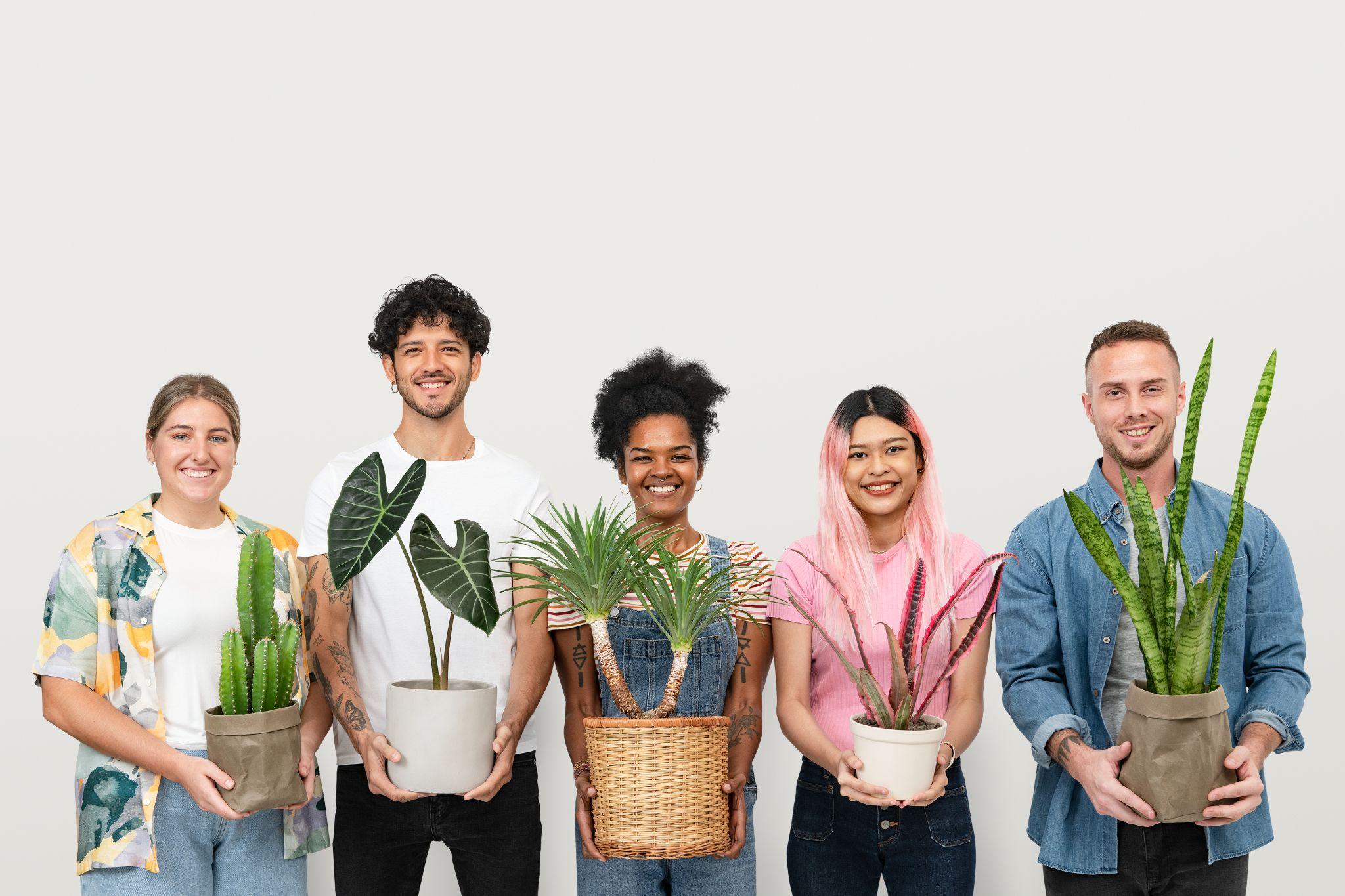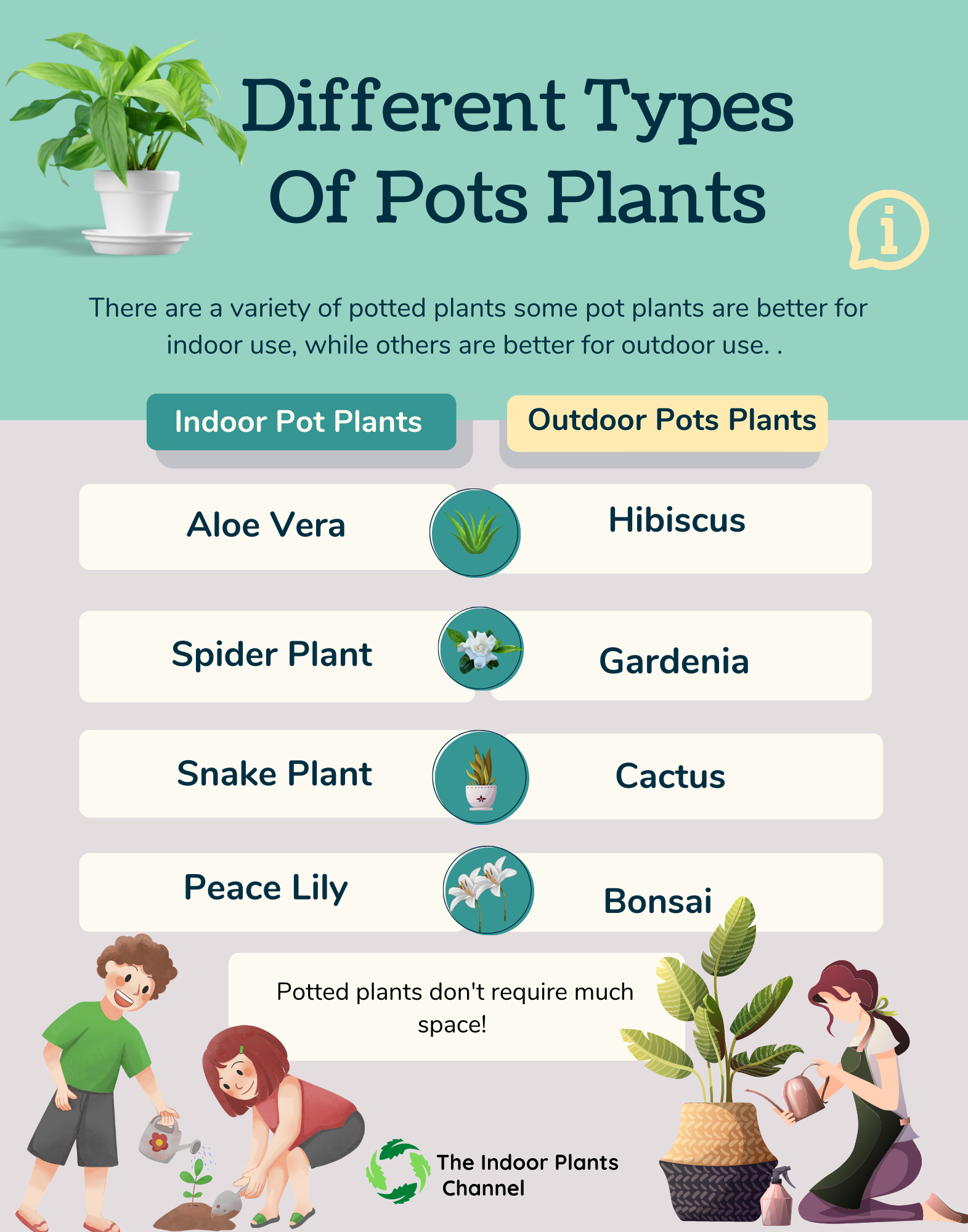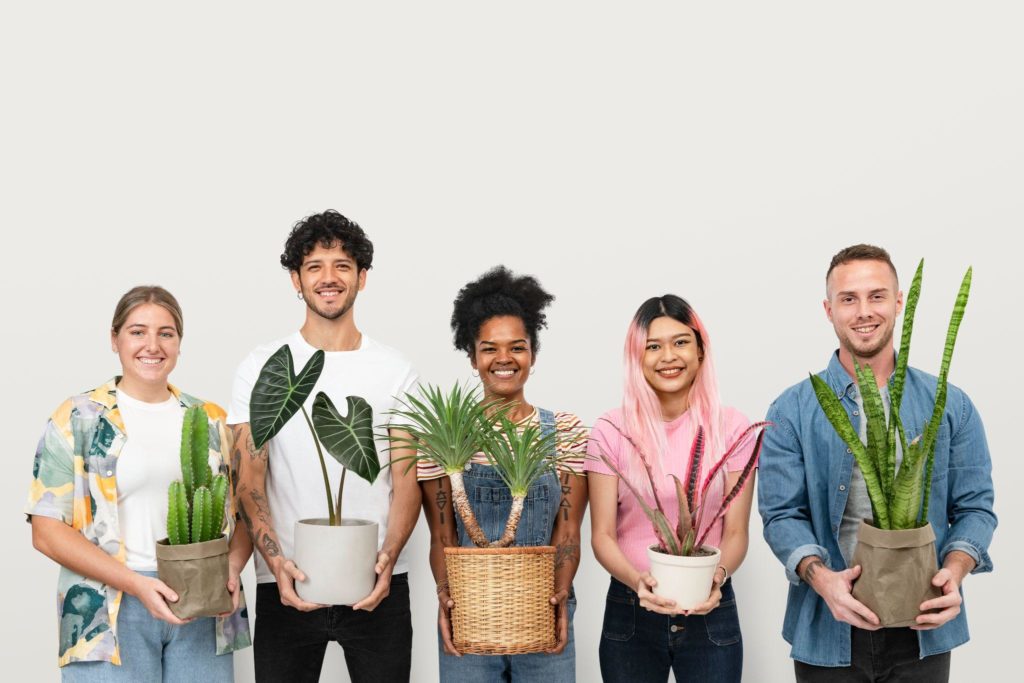Pots plants are a type of indoor plant that are typically grown in pots or containers. These plants are easy to care for and make a great addition to any home or office. Don’t let a lack of space keep you from enjoying the beauty and benefits of plants! Pots plants come in a variety of shapes and sizes, and can be found in many different colors. Some common pots plants include ferns, ivy, and peace lilies.
I think that I shall never see A poem as lovely as a tree. A tree whose hungry mouth is prest

Credit: Freepik
If you’re looking for a way to add a little bit of life to your home without having to worry about taking care of a pet, then pot plants are the way to go! In this guide, we’ll show you everything you need to know about choosing and caring for your new plants.
The Benefits Of Pots Plants
Pots plants are a great way to bring some life into your home without having to deal with the hassle of a full-fledged garden. Here are some of the benefits of pot plants:
- Pot plants can help purify the air in your home.
- They can boost your mood and help you relax.
- Pot plants can help you focus and increase your productivity.
- They can also help reduce stress levels.
- Pot plants make great decorative pieces for your home.
The Different Types Of Pots Plants
There are a variety of potted plants that can be used for different purposes. Some pots plants are better for indoor use, while others are better for outdoor use.

Here are some of the different types of pots plants:
Indoor Pot Plants
- Aloe Vera Plant: The aloe vera plant is a succulent plant that is often used for its medicinal properties. The gel from the aloe vera plant can be used to treat burns and other skin conditions.
- Snake Plant: The snake plant is a succulent plant that is known for its ability to purify the air. Snake plants are also very easy to care for, making them a great option for those who are new to plant care.
- Spider Plant: The spider plant is a popular houseplant that is known for its ability to produce oxygen. Spider plants are also very easy to care for and can tolerate a wide range of conditions.
- Peace Lily: The peace lily is a flowering plant that is known for its ability to filter out harmful toxins from the air. Peace lilies are also very easy to care for and can tolerate low light conditions.
Outdoor Pots Plants:
- Hibiscus: The hibiscus is a flowering plant that is known for its beautiful flowers. Hibiscus plants need a lot of sunlight and water to thrive.
- Gardenia: The gardenia is a flowering plant that is known for its sweet-smelling flowers. Gardenia plants need a lot of sunlight and water to thrive.
- Cactus: The cactus is a succulent plant that is known for its ability to store water. Cacti need very little water and can tolerate hot, dry conditions.
- Bonsai: The bonsai is a tree that is trained to grow in a small pot. Bonsai trees need a lot of sunlight and water to thrive.
Choosing the Right Plant & Caring For It
The first step is to choose the right plant for your home. There are a few things to consider when making your selection:
- Light: How much sunlight does your home get? If you have a lot of windows and natural light, you can choose a plant that needs more sun. If your home is on the darker side, choose a plant that doesn’t require as much light.
- Space: How much space do you have for your plant? Some plants can get pretty big, so make sure you have enough room for it to grow, specially if you are considering a balcony garden. You also need to consider the size of the pot you’ll be using. A plant that needs a large pot will take up more space than a plant that doesn’t need a large pot.
- Water: How often do you want to water your plant? Some plants need to be watered every day, while others can go a week or more without needing any water. Over-watering can kill a plant, so be sure to only give it as much water as it needs.
- Fertilizer: Use a fertilizer that’s specifically designed for plants. This will help your plant grow healthy and strong.
- Pests: Check your plant regularly for pests, and if you see any, treat them immediately.
The Best Pots Plants For Low-light Conditions
If you live in an apartment or another type of dwelling with little natural light, you may think that your options for pot plants are limited. However, there are actually a number of different plants that can thrive in low-light conditions.
Here are some of the best pots plants for low-light conditions:
- Snake Plant
- ZZ Plant
- Philodendron
- Pothos
- Dracaena
- Peace Lily
The snake plant, also known as the mother-in-law’s tongue, is a tough and resilient plant that can tolerate low light levels very well. It is also a very drought-resistant plant, so it is perfect for those who tend to forget to water their plants regularly.
The ZZ plant is another plant that does well in low-light conditions. It is a very slow-growing plant, so it is perfect for those who do not want to deal with a lot of upkeep.
Philodendrons are a type of vine that can be trained to grow up a trellis or other support. They are very easy to care for and do well in low-light conditions.
Pothos are another type of vine that does well in low-light conditions. They are very easy to care for and can tolerate a wide range of conditions.
Dracaenas are a type of succulent that does well in low-light conditions. They are very drought-resistant and do not require a lot of care.
The peace lily is a beautiful plant that does well in low-light conditions. It is also very easy to care for and does not require a lot of water.
The Best Pots Plants For Purifying The Air
There are many benefits to pot plants, including purifying the air.
Here are 10 of the best pot plants for purifying the air:
- Aloe Vera
- Bamboo Palm
- Boston Fern
- Chrysanthemum
- Cobra Plant
- English Ivy
- Gerbera Daisy
- Golden Pothos
- Peace Lily
- Snake Plant
Aloe vera is a popular succulent that is known for its healing properties. It is also great at purifying the air, as it removes formaldehyde and benzene from the atmosphere.
Bamboo palm is a type of palm that grows in the tropics. It is a very effective air purifier, as it removes formaldehyde, carbon monoxide, and other pollutants from the air.
Boston fern is a type of fern that is native to North America. It is an excellent air purifier, as it removes formaldehyde, xylene, and toluene from the atmosphere.
Chrysanthemums are popular flowers that come in a variety of colors. They are also great at purifying the air, as they remove benzene, formaldehyde, and trichloroethylene from the atmosphere.
Cobra plant is a type of succulent that is native to Africa. It is very effective at purifying the air, as it removes formaldehyde, benzene, and trichloroethylene from the atmosphere.
English ivy is a type of ivy that is native to Europe. It is an excellent air purifier, as it removes carbon monoxide, formaldehyde, and other pollutants from the atmosphere.
Gerbera daisies are popular flowers that come in a variety of colors. They remove benzene, formaldehyde, and trichloroethylene from the atmosphere.
Golden pothos is a type of vine that is native to the Solomon Islands. It is an excellent air purifier, as it removes formaldehyde, carbon monoxide, and other pollutants from the atmosphere.
Peace lilies are popular flowers that come in a variety of colors. They are very good at purifying the air, as they remove benzene, formaldehyde, and trichloroethylene from the atmosphere.
Snake plants are popular succulents that are native to Africa. They are very effective as air purifiers as they remove formaldehyde, benzene, and trichloroethylene from the atmosphere.
The Best Pots Plants For Beginners
If you’re new to the world of plants, it can be daunting trying to figure out which ones are best for you. But don’t worry, we’re here to help!
Here are 10 of the best pot plants for beginners:
- Aloe vera
- Snake plant
- Spider plant
- Succulents
- Jade plant
- Rubber plant
- Peace lily
- Pothos
- Dracaena
- Philodendron
One of the most popular pot plants around, aloe vera is also one of the easiest to care for. It thrives in bright, indirect sunlight and doesn’t need much watering – in fact, too much water can actually be harmful to this plant.
Another easy-to-care-for plant, snake plants are perfect for beginners. They’re very tolerant of different conditions, including low light and irregular watering.
Spider plants are another great option for beginner plant parents. They’re very easy to propagate, so you can quickly have a lot of plants from just one mother plant. They’re also tolerant of a wide range of conditions, making them very low-maintenance.
Succulents are a great choice for beginner plant parents because they’re very drought-tolerant. This means they don’t need a lot of water, making them ideal for those who might forget to water their plants regularly. Just make sure they’re getting enough sunlight – too much shade can cause them to stretch and become leggy.
A jade plant is a beautiful, easy-to-care-for option for beginner plant parents. They prefer bright, indirect sunlight and well-draining soil. They’re also very drought-tolerant, so you don’t need to worry about watering them too often.
Rubber plants are a great choice for beginner plant parents because they’re very tolerant of different conditions. They’re also very easy to propagate, so you can quickly have a lot of plants from just one mother plant.
Peace lilies are a beautiful, easy-to-care-for plant that thrive in low-light conditions. They don’t need much water, so they’re perfect for those who might forget to water their plants regularly. Just be sure to keep them out of direct sunlight, as too much sun can scorch their leaves.
Pothos are a great choice for beginner plant parents because they’re very tolerant of different conditions. They’re also very easy to propagate, so you can quickly have a lot of plants from just one mother plant.
Dracaenas are a great choice for beginner plant parents because they’re very tolerant of different conditions. .
Philodendrons are a great choice for beginner plant parents because they’re very tolerant of different conditions.
10 Pots Plants That Are Easy To Care For
- Aloe Vera
- Snake Plant
- Pothos
- Philodendron
- Dracaena
- Fiddle Leaf Fig
- Rubber plant
- ZZ plant
- Boston fern
- Peace lily
Aloe Vera is a succulent, so it doesn’t need much water to survive. It’s a great plant for beginner gardeners because it’s very forgiving. Be sure to give it a bright spot to grow in, and water it about once a week.
Snake plants are also known as mother-in-law’s tongue or sansevieria. They’re nearly indestructible, so they’re perfect for beginner gardeners. Snake plants prefer bright, indirect light, and should be watered about once a month.
Pothos are vines that are very easy to care for. They can tolerate low light conditions, and only need to be watered about once a week. Pothos are a great plant for beginner gardeners because they’re very forgiving.
Philodendrons are a type of evergreen that is very easy to care for. They can tolerate low light conditions, and only need to be watered about once a week.
Dracaenas are a type of evergreen that is very easy to care for. They can tolerate low light conditions, and only need to be watered about once a week.
Fiddle leaf figs are a type of tree that requires little care and maintenance. They can tolerate low light conditions, and only need to be watered about once a week.
Rubber plants are a type of tree that doesn’t require much care. They can tolerate low light conditions, and only need to be watered about once a week.
ZZ plants are a type of succulent that is very easy to care for. They can tolerate low light conditions, and only need to be watered about once a month. ZZ plants are a great plant for beginner gardeners because they don’t need much maintenance.
Boston ferns are a type of fern that is very easy to care for. They prefer bright, indirect light, and should be watered about once a week. Boston ferns are a great plant for beginner gardeners because they’re very forgiving.
Peace lilies are a type of flower that is very easy to care for. They prefer bright, indirect light, and should be watered about once a week. Peace lilies are a great plant for beginner gardeners because they can forgive neglect.
How To Care For Your Pots Plants
The best way to keep your pot plants healthy is to give them the right amount of water and fertilizer, and to put them in the right kind of light.
- Watering
How often you need to water your pot plants depends on the kind of plant, the size of the pot, and the weather. In general, you should water your plants once a week, and more often in hot weather. If the leaves of your plant start to droop, that means it needs water.
- Fertilizing
Fertilizer helps your plants grow strong and healthy. You can buy fertilizer at a gardening store. Most plants need fertilizer every two weeks.
- Light
All plants need sunlight to grow. But different plants need different amounts of sunlight. Some plants need a lot of sunlight, and some need only a little. If you are not sure how much sunlight your plant needs, ask a gardener or look it up online.
Frequently Asked Questions
Which plants are best for apartments?
There are a variety of plants that can do well in an apartment setting. Some good options include: snake plants, zz plants, pothos, philodendrons, and fiddle leaf figs.
How often should I water my plants?
This depends on the plant, the size of the pot, the type of potting mix, and the temperature and humidity in your home. As a general rule of thumb, most plants need to be watered every 7-10 days.
What type of pots are best for plants?
This also depends on the plant. Some plants do better in plastic pots, while others do better in ceramic or terracotta pots. It’s a good idea to do some research on the plant you’re interested in to see what type of pot it prefers.
How do I know if my plant is getting too much or too little water?
The best way to know is to check the soil. If the soil is dry to the touch, it’s time to water. If the soil is soggy or mushy, it’s time to cut back on the watering.
My plant leaves are turning yellow. What’s wrong?
There are a number of reasons why plant leaves might turn yellow. It could be a sign of too much or too little water, too much or too little sunlight, or a nutrient deficiency.
How do I fertilize my plants?
Fertilizing plants is important to help them grow and stay healthy. There are a number of different ways to fertilize plants, including using liquid fertilizer, granular fertilizer, or slow-release fertilizer.
I think my plant is sick. What should I do?
If you think your plant is sick, the first thing you should do is check for pests. If there are pests on the plant, you’ll need to treat them. If there are no pests, it could be a nutrient deficiency or a problem with the roots.
What is the best way to propagate plants?
There are a few different ways to propagate plants, including taking stem cuttings, taking root cuttings, and division.
How do I repot a plant?
When repotting a plant, it’s important to choose a pot that is only one size larger than the current pot. You’ll also need to add fresh potting mix to the new pot.
I’m moving to a new apartment. How can I take my plants with me?
If you’re moving to a new apartment, it’s important to pack your plants carefully. The best way to do this is to wrap the pots in newspaper and then place them in a box.
Conclusion
If you’re an apartment dweller, you know that space is limited. But that doesn’t mean you can’t have a beautiful garden! These 10 container pot plants are perfect for small spaces, and they’ll add some life to your home. Fortunately, they’re the best plants for beginners, so you don’t have to worry. Check out the plants above and comment your opinions.
